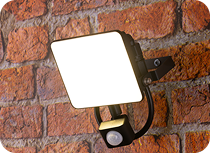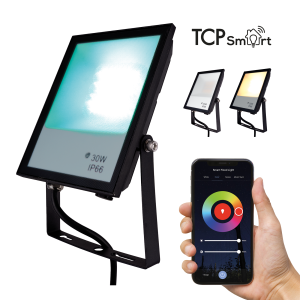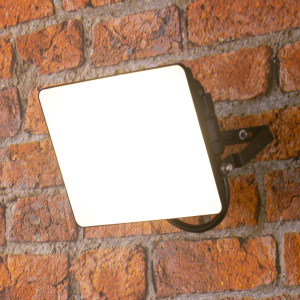When the sun goes down, the right outdoor lighting can completely change the atmosphere and functionality of your home. It’s not just about visibility — it’s about feeling secure, creating ambience, and making the most of your outdoor space. Flood lights are one of the most versatile options available, but many homeowners aren’t sure where to start. If you’re thinking about upgrading your exterior lighting, this guide will help you understand the essentials.
What are floodlights?
Floodlights are outdoor lighting fixtures that project a wide, powerful beam to illuminate large areas around your home. Whether you’re lighting up a driveway, a back garden, or the area near a shed or side path, floodlights help improve visibility and add a sense of security after dark. Designed for function and style, they’ve become a popular choice for homeowners looking to make their property safer, more practical, and more attractive at night.
Types of floodlights
Homeowners today can choose from a variety of floodlight types, each offering unique benefits depending on where and how you plan to use them.
- LED floodlights – LED floodlights are the most energy-efficient option available, using significantly less electricity than halogen alternatives while offering high brightness and longevity. They typically last between 30,000 and 50,000 hours, making them a low-maintenance solution for homeowners. Available in a range of colour temperatures and sleek designs, LED floodlights are ideal for illuminating patios, driveways, garden paths, or any space where reliable and stylish lighting is needed.
- Halogen floodlights – Halogen floodlights offer a warm, powerful glow and reach full brightness instantly, making them suitable for areas where immediate lighting is essential. They are usually cheaper to buy initially, which can appeal to homeowners on a tight budget. However, halogen bulbs consume more electricity, run hotter, and require more frequent bulb changes compared to LEDs, making them less efficient and cost-effective in the long term.
- Solar-powered floodlights – Solar-powered floodlights are an excellent eco-friendly choice for homeowners who want to reduce energy bills and avoid complicated installations. These lights charge via built-in solar panels during the day and turn on automatically at night, requiring no wiring or mains electricity. Ideal for remote or hard-to-reach areas such as fences, garden sheds, or pathways, they’re simple to install — though they do rely on adequate sunlight to perform reliably throughout the year.
- Motion sensor floodlights – Motion sensor floodlights activate automatically when movement is detected, making them perfect for enhancing security and reducing energy waste. They’re commonly installed near front doors, garages, or along side passages, providing instant light when you or someone else approaches. This type of lighting deters intruders, improves convenience when arriving home at night, and conserves energy by staying off when not needed.
- Smart floodlights – Smart floodlights Smart floodlights allow homeowners to control outdoor lighting through mobile apps, voice assistants, or home automation systems, making them a versatile choice for security lighting. You can schedule lighting times, dim brightness, change colours (in RGB models), or receive alerts when motion is detected — all from your phone. These are ideal for tech-savvy households looking for added convenience, customisation, and seamless integration with other smart home devices.
Benefits of floodlights
Floodlights offer a wide range of practical advantages for homeowners, beyond simply brightening outdoor areas.
- Improved security – A well-lit home with LED flood lights is far less attractive to burglars, trespassers, or opportunistic vandals. Floodlights eliminate hiding spots and make suspicious activity more visible, especially when paired with motion sensors or smart lighting systems that activate when movement is detected. This added layer of protection gives homeowners greater peace of mind during the night or when away from home.
- Better safety – Outdoor lighting significantly reduces the risk of accidents around the home by improving visibility in key areas such as driveways, garden paths, steps, and entrances. This is especially helpful in autumn and winter, when early darkness and slippery surfaces can increase the chance of trips or falls. Floodlights help ensure that everyone — from family members to delivery drivers — can move around your property safely after dark.
- Enhanced kerb appeal – Floodlights aren’t just practical — they can also enhance the overall look of your home. When positioned thoughtfully, they can highlight landscaping features, architectural details, or outdoor entertaining areas, making your property feel warm and welcoming at night. This not only improves the experience for you and your guests but can also boost the perceived value of your home.
- Energy savings – Modern floodlight options like LED and solar-powered models use far less electricity than older halogen systems. LEDs are especially efficient, providing high brightness with minimal energy use, while solar lights run entirely off stored sunlight, costing nothing to operate. These options allow you to enjoy long-lasting, reliable lighting without a significant impact on your energy bills.
What to consider when choosing the right floodlight
To select the ideal floodlight for your home, it’s important to think about a few practical details that affect performance, style, and long-term satisfaction.
- Brightness – Measured in lumens, brightness determines how well an area will be lit. For most gardens, patios, or driveways, 700 to 1500 lumens is usually enough to provide clear visibility without being overpowering. Larger spaces or security-focused installations may benefit from a slightly higher lumen count, but excessive brightness can cause glare or disturb neighbours.
- Beam angle – This refers to how wide the light spreads from the fixture. A narrow beam (under 60°) is great for spotlighting specific areas like doorways or garden features, while a wider beam (over 100°) is better suited for lighting broad areas like a lawn, driveway, or fence line. Choosing the right angle ensures your lighting is effective without wasting energy or creating dark spots.
- IP rating – The Ingress Protection (IP) rating tells you how resistant the floodlight is to water and dust. For outdoor use in the UK, look for at least an IP65 rating to handle rain, wind, and other weather conditions year-round. A good IP rating ensures your lights stay functional and safe, even in harsh climates or when mounted low to the ground.
- Design and placement – Floodlights come in various shapes and finishes, from sleek modern casings to more traditional looks. Choose a design that suits your home’s exterior style so the light blends in rather than stands out. Strategic placement is just as important — install the light where it illuminates the area effectively without pointing into windows, neighbouring properties, or causing unnecessary glare.
Final thoughts
Floodlights are a smart, versatile investment for any homeowner wanting to enhance security, improve visibility, and create a welcoming outdoor environment. By understanding the different types available and knowing what features to look for, you can choose the right lighting solution that works both functionally and aesthetically. Whether you’re aiming for peace of mind, better safety, or a boost in kerb appeal, the right floodlight can make a lasting difference to your home. With thoughtful placement and the right technology, you’ll enjoy brighter, safer evenings for years to come.






